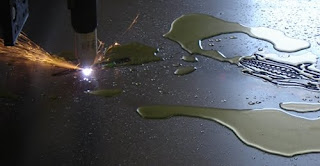CNC (Computer Numerical Control) machines have successfully transformed the manufacturing industry from using hard-wired machines, whose operating parameters could not be changed, to machines that can cut curves as easily as straight lines and can produce complex 3-D structures with ease.
In the mid-1970s, Thermwood Corporation developed the first commercial CNC machine tool control and used it to build machinery to trim its plastic parts. Thermwood then began selling this trim equipment for plastics and woodworking applications and the CNC router was born. Thermwood is currently the oldest CNC router company and continues to offer products for the woodworking, plastics, and aerospace industries.
Problem
An important process for their CNC machines is axis alignment verification. Thermwood was using stationary-beam laser interferometers to check for straightness and level, as well as to acquire data for linear lead screw compensation. All orthogonal measurements had to be accomplished with mechanical instruments such as precision machine squares.
The mechanical instruments, however, were not the desired solution, as they required multiple setups, which in turn required a great deal of back-tracking to verify alignment states. There was no quick or easy way to monitor changes resulting from interactions within the process. This often required multiple interim checking operations, which became time consuming.
Thermwood was also looking for a solution to volumetric axis compensation. With their large 5-axis routers and mills that perform precision 3-dimensional work, minute variations in head positioning can become a major issue, as they are adding a conspicuous third dimension into the mix.
Solution
The FARO Laser Tracker became that solution for Thermwood. The Laser Tracker has not only provided them with a better way to perform axis alignment verification, but has also allowed them to successfully perform volumetric axis compensation.
Axis Alignment Verification
The implementation process of the Laser Tracker for alignment applications proceeded very quickly. “Enough cannot be said for the trainer,” said David Stutsman, Engineer at Thermwood. “Within a week, our cumbersome mechanical measuring instruments and levels were gathering dust.”
In this process, Thermwood uses the Laser Tracker to measure and map linearity in preset increments, as well as the orthogonal relationship between the various axes on the machine. Alignment technicians utilize this data to make critical adjustments to the machine components, after which the Laser Tracker verifies the proper state of alignment.
The initial Laser Tracker measurement setup is performed in the early stages of machine assembly, while the machine is only comprised of the various weldments with all of the rails mounted. During this initial operation, the Laser Tracker’s SMR (spherically mounted retroreflector) is fitted onto a special fixture, which allows it to be attached to each rail and moved manually along them. This fixture is then fitted with precision rail bearings, which allows it to track the rail very precisely. This initial setup makes it possible for Thermwood to take readings and make major adjustments in the assembly positions of the rails, based on information derived from the Laser Tracker.
Once the initial leveling and alignments are finished, machine assembly is completed, the servo drive system is fitted, and the computer control is installed. After the initial power-up, the machine is again checked using the Laser Tracker, then additional minor calibration adjustments are performed if necessary.
Volumetric Compensation
Volumetric compensation required a little more time to implement, as all of the software for this application was developed in-house. As a CNC machinery manufacturer, Thermwood has always developed its own software and built its own controls. “Having our software engineers on staff benefited us greatly in the development of this process,” said Stutsman. “We believe that our system is on the leading edge of this technology.”
In this process, Thermwood acquires positioning data in a matrix pattern on multiple planes. By adding multiple planes, they are able to represent the entire cubic space displaced by the machines’ axes. The entire work envelope of the machine is mapped to provide absolute positioning data at numerous predetermined points. A correction table is developed by triangulating between the various points in volumetric model space, measuring the error for each position, and formulating a table of correction data to be loaded into the machine control and accessed during program execution.
The method of compensating for error during the program cycle is essentially the same as with linear compensation, except that during program execution the control is required to simultaneously track and compare axis movement on three distinct orthogonal paths, and to affect positional corrections correspondingly on all three axes, in phase with program execution.
“Writing the software that allows the Laser Tracker to communicate with the machine control was a relatively simple task,” stated Stutsman. “On the other hand, developing algorithms to interpolate error at any given point within the operational envelope was a daunting task, requiring months to complete. However, this effort is paying off in terms of greatly increased positioning and tracking accuracy. We feel that this has given us a position of superiority over other CNC manufacturers.”
Return on Investment
The two FARO Laser Tracker units are in use nearly every day at Thermwood, performing either or both of the applications. Consistencies of their CNC machines and their overall quality have both been impacted positively since implementing the Laser Trackers.
The amount of time required for machine alignments has been cut to less than half. What once took up to eight hours to complete can now be accomplished in approximately three. The greatest savings are realized on the larger, more complex machines. In addition, Thermwood can now perform volumetric compensation, which would not have been possible without the Laser Tracker.
“The FARO Laser Tracker has had a significant positive impact on the overall quality and value of our product,” said Stutsman. “We expect gains in market share as a result.”

















